Does Height Influence Men’s Sexual Success?

‘Chad’ is a colloquialism that has by now entered popular internet parlance. ‘Normies’ often use the term as a lighthearted way of referring to someone doing something brazen or foolhardy, or as a sort of synonym for ‘badass’.
In the incel subculture which popularized it however, it’s usually used of course to refer to a male who is highly sexually successful. Opinions on what determines this success tend to vary only minimally, ranging from it being mostly to fully determined by physical attractiveness – which is in turn determined mostly by facial attractiveness and height. So it’s also basically synonymous with ‘physically attractive male’, as these two characteristics are thought to be essentially interchangeable.
All men are thought to aspire to chad’s ‘slayer’ lifestyle of having an endless stream of casual sex, but owing to genetic limitations the vast majority are unable to. Maybe with enough ‘looksmaxxing’, some on the edge of chadhood may be able to ‘ascend’ and join the ranks of the sexual elite.
Other than that though, men who ‘won the genetic lottery’ are essentially blessed with the experience of a Jihadist in paradise, while the ‘sub-8’ peasants are doomed to a life of desperation and unfulfilled desires.
Because of this ‘unearned privilege’ that chad is thought to enjoy, the ‘black piller’ becomes incredibly envious and resentful of him.
Is this chadphobia justified however? One way to answer this question is to first ask whether it’s even true, do tall and handsome men really ‘get all the action’?
I was inspired by Date Psychology’s illuminating article Male Attractiveness and Sexual Partner Count – which in a meta-analysis found only a very weak 0.14 correlation between men’s physical attractiveness and sexual partner count – to examine the other main trait considered to be a determinant of ‘chad’ status: height.
First I’ll begin by going over all the studies I could find relating to this question, before pooling them together in a meta-analysis.
Studies
Rahman et al. (2005): Sexually dimorphic 2D:4D ratio, height, weight, and their relation to number of sexual partners
From a sample of 159 men with a mean age of 32.3, a significant correlation of .17 between height and total number of sex partners was found.

They also broke it down by race. There was no longer a significant association between height and number of sex partners.
For white men, there was no association at all between height and opposite-sex sex partners, only same-sex.
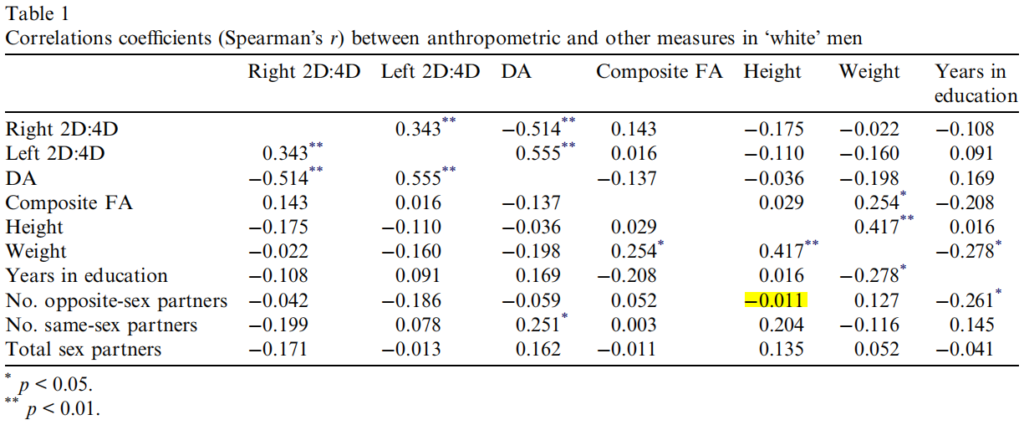
For non-white men these associations were reversed, but remained non-significant.
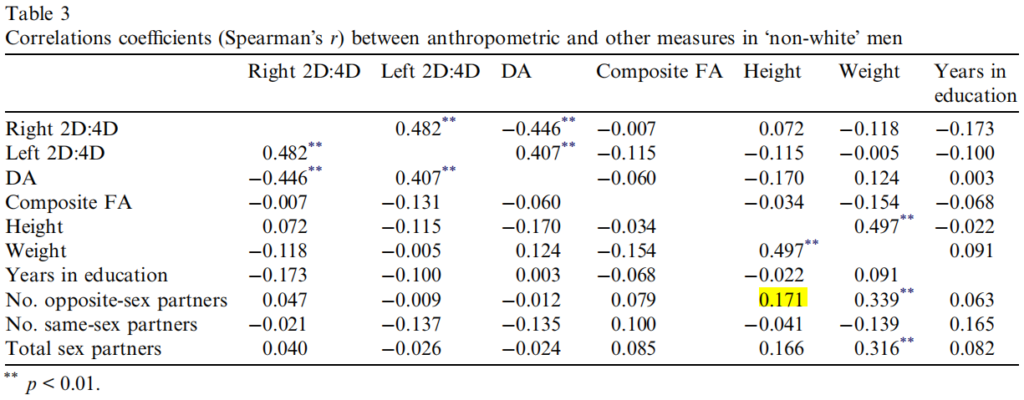
Chad is not off to a great start.
Rhodes et al. (2005): Attractiveness and sexual behavior: Does attractiveness enhance mating success?
From a sample of 166 men with a mean age of 20.3, a Kendall’s tau correlation coefficient of .12 between height and sexual partners was found, and 0.16 with short-term partners. They also found a correlation of -.13 with age of first sex, implying that taller men lose their virginity slightly earlier than normal. Extra-pair copulations and long-term partners weren’t significantly associated with height however.
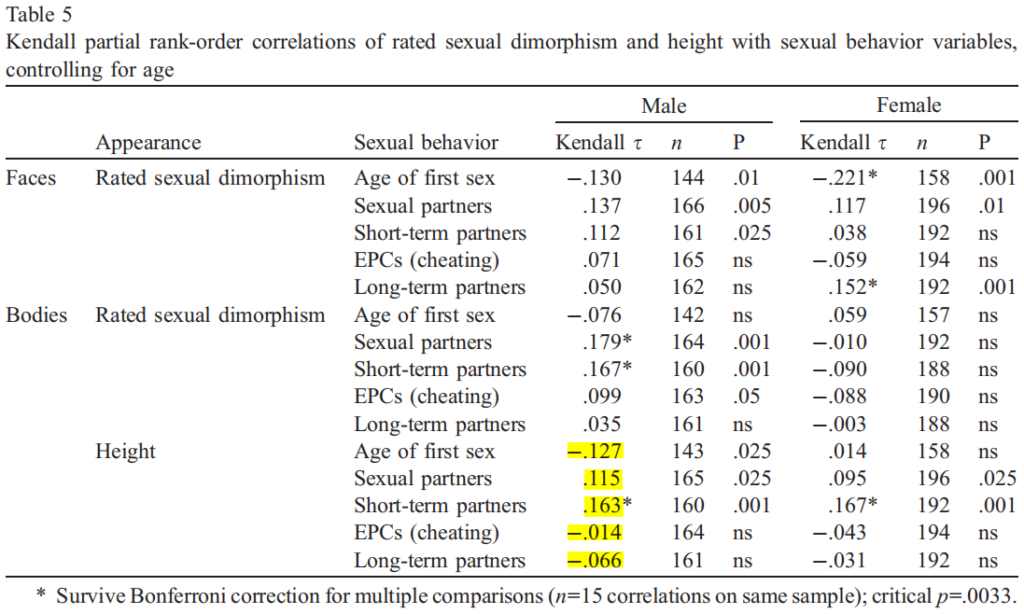
What’s interesting is that we also find a correlation of .1 between height and sexual partners and .17 with short-term partners for women. This seems to call into question the assumption that these correlations are simply a reflection of desirability. Still, we have a significant effect, which even if it’s small is progress.
Hill et al. (2013): Quantifying the strength and form of sexual selection on men’s traits
From a sample of 63 fraternity members with a mean age of 19.9, a negative but not significant association of -.18 β between height and mating success was found, measured by sexual partners in the past year, despite height being somewhat correlated with short-term attractiveness ratings by the female participants. One step forward, one step back.
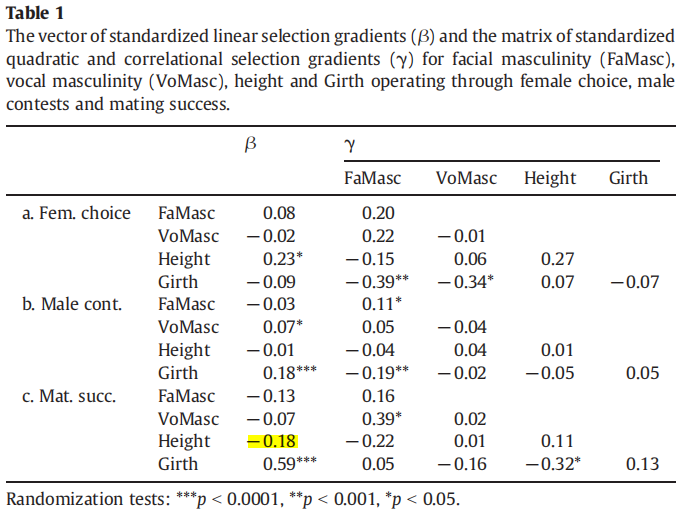
They conclude from the fact that since fighting ability (‘male contests’) rated by other men was a better predictor of mating success than female-rated attractiveness, male intra-sexual competition may still be a salient component of sexual selection.
Frederick & Jenkins (2015): Height and Body Mass on the Mating Market: Associations With Number of Sex Partners and Extra-Pair Sex Among Heterosexual Men and Women Aged 18–65
60,058 heterosexuals responded to a survey on an NBC News’ website (conducted on an earlier year than this study’s publication date). 52% were men with a mean age of 40, and 48% were women with a mean age of 34. This is more like it, if there’s an effect we’ll definitely see it in a dataset of this magnitude.
This graph shows the number of lifetime sex partners of respondents by height:
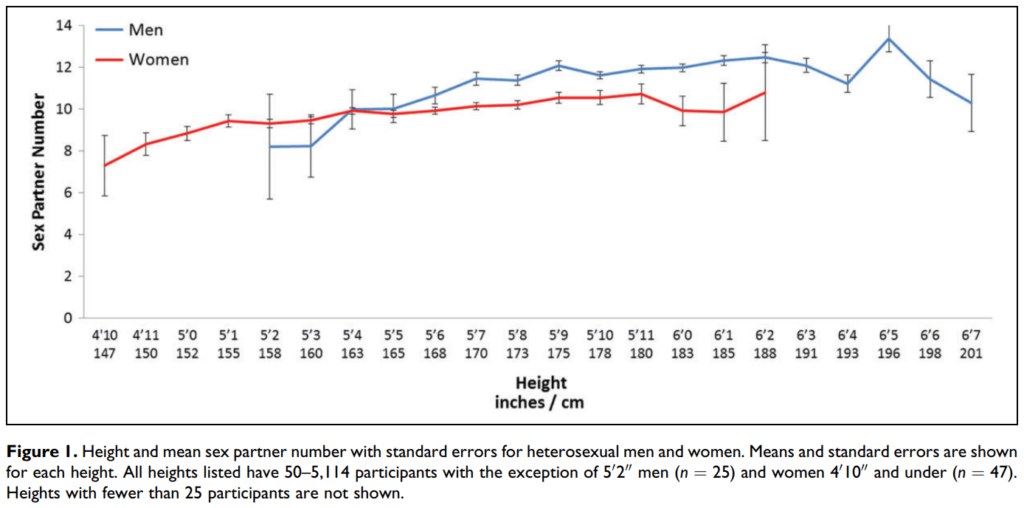
We see an effect in the expected direction among short men, but even 5’2 turbomanlets reported about 8 partners on average – so even if you’re in the bottom 1% of height it’s far from a death sentence, and the effect past 5’7 was barely noticeable. 5’9 to 6’2 men reported some 12 partners on average, just 50% more than the very shortest men. We also see some indication of a non-linear relationship whereby the trend seems to begin reversing past the 6’2 point. It doesn’t seem like very tall men are any more ‘successful’ than somewhat below average height men.
In this table, very short for men was defined as 5’2-5’4, short 5’5-5’7, average 5’8-5’10, tall 5’11-6’1, very tall 6’2-6’4, and extremely tall 6’5+. The effect size when it came to the degree of difference between very short and average height men was -.19, and between very short and tall men it was -.22 (interestingly, the effect sizes were similar for very short women). A Cohen’s d value of .2 is generally considered to be when it qualifies as at least a ‘weak’ effect, so we see a barely weak effect for very short men, but an at best trivial effect among the rest.
The median sex partner numbers for men were also all an identical 7 with the exception of very short men who had 5.

We see similar trends here in the categories of more than 5 sex partners, more than 14 sex partners, extra-pair sex, and currently single, with only the very short cohort noticeably differing from the rest, but even then the differences were small.

The beta coefficients for men was .07, and for women .04, with men’s dropping to .05 when including interaction effects.
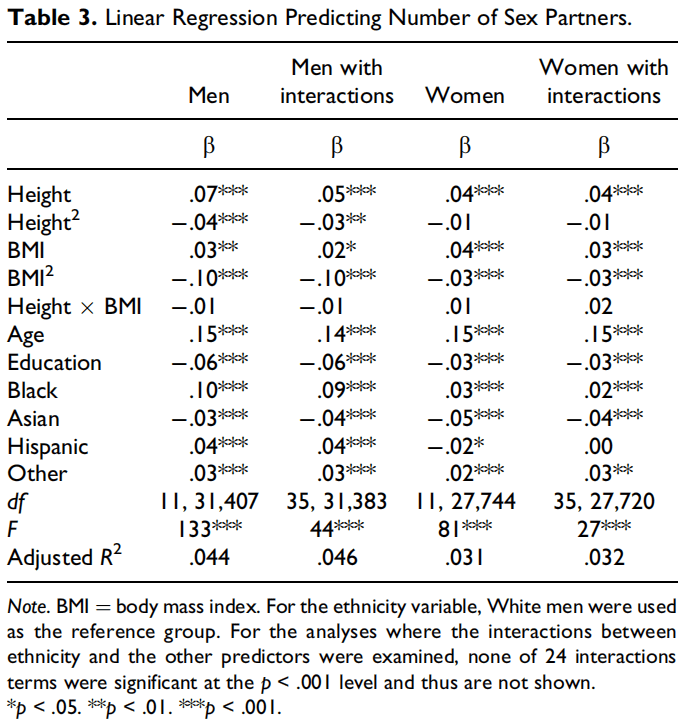
So when we have a massive sample size, we do see an effect emerge, but it’s definitely nothing close to a ‘black pilling’ effect size.
Kordsmeyer et al. (2018): The relative importance of intra- and intersexual selection on human male sexually dimorphic traits
From a sample of 164 male heterosexuals with a mean age of 24.2, no effect of height on mating success was found. There also wasn’t a significant correlation between height and female rated sexual attractiveness in this study.
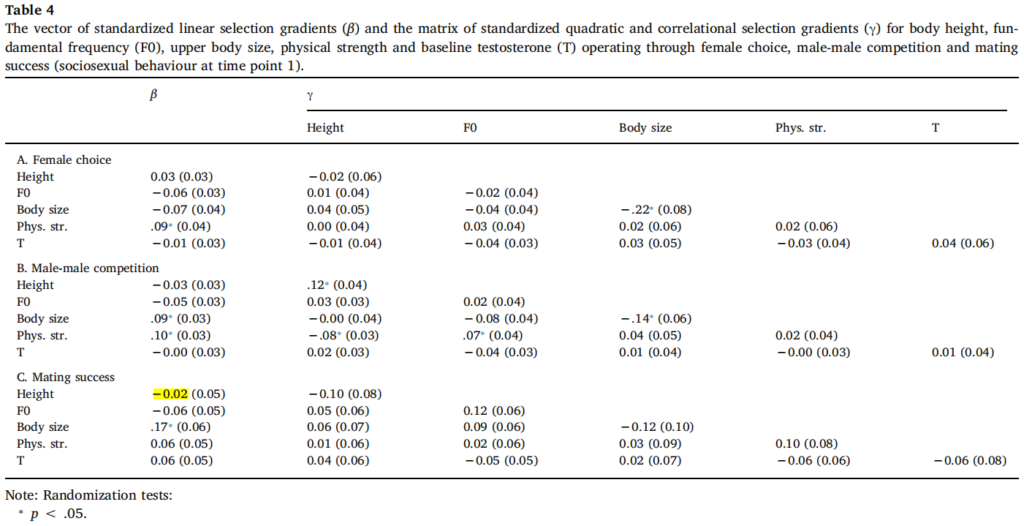
When it came to the specific behavioural items of the Sociosexual Orientation Inventory, height correlated with sexual partners in the past year at 0.13, with total one-night stands at 0.05, and with sexual partners without relationship interest at 0.13. None of these associations reached significance.
18 months later they filled out a follow up questionnaire. The correlations remained similar at 0.13, 0.06, and 0.1.
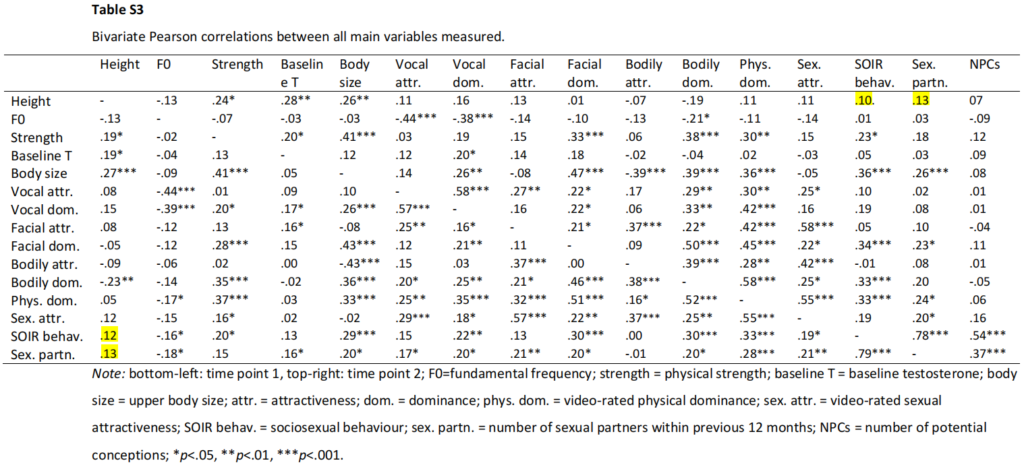
They replicated the findings of Hill et al., 2013, in that physical dominance was a better predictor than sexual attractiveness on mating success, concluding that intrasexual competition may indeed play a larger role than female selection. It’d be interesting to determine exactly how this plays out as it doesn’t seem like it’s as overt as crushing your mating rivals in battle or guarding your harem.
Seffrin & Ingulli (2020): Brains, brawn, and beauty: The complementary roles of intelligence and physical aggression in attracting sexual partners
Waves 1-4 of the National Longitudinal Study of Adolescent to Adult Health (1994-2008) were analyzed, with 5,635 males in the final sample.
A miniscule yet significant effect of .03 of height on lifetime sex partners was found, but none on non-relationship sex partners or sexual infidelity.
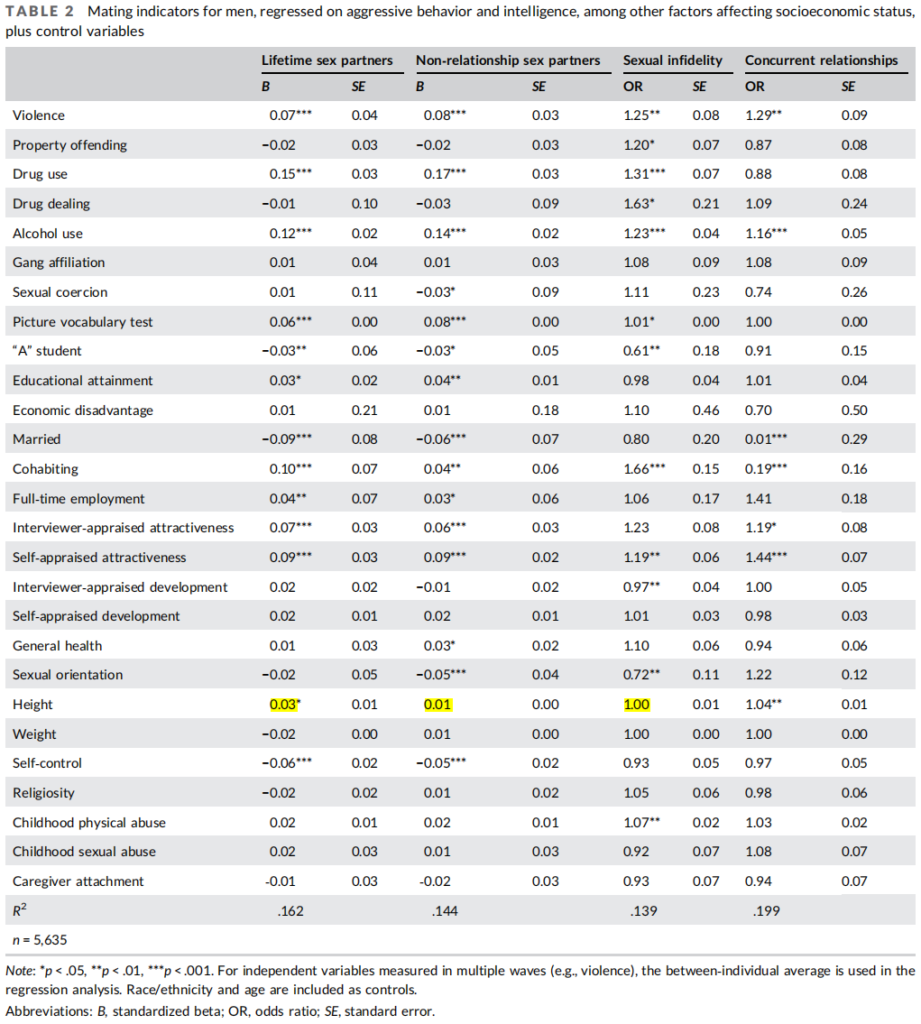
Plots
Now it’s time to bring them together. I’ve added my own analysis of nationally representative US data from Wave III of Add Health (The National Longitudinal Study of Adolescent to Adult Health), the NSFG (National Survey of Family Growth), the NHANES (National Health and Nutrition Examination Survey), and the GSS (General Social Survey).
I set the upper lifetime partner limits to 200 (except for the NSFG where it’s naturally capped at 50+) to make it more robust to outliers (which may also be of questionable authenticity). I ran some Kendall and Spearman rank correlation tests and found barely any differences in the outputs (Kendall’s was usually very slightly lower and Spearman’s slightly higher) so decided to leave those couple of studies in (they’d have no chance of affecting the overall result anyway). I have also added a few studies which I’ve discovered since posting this, and reran the survey correlations as I found a way to do weighted correlations (the survey package comes with no inbuilt correlation function).
The overall estimate: .05. This means that height would explain a trivial 0.25% of the total variance in lifetime sexual partners.
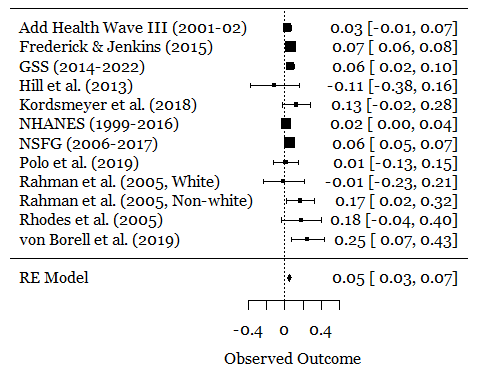
Here is what the NSFG, NHANES, and Add Health datasets look like in the form of scatterplots with loess curves:

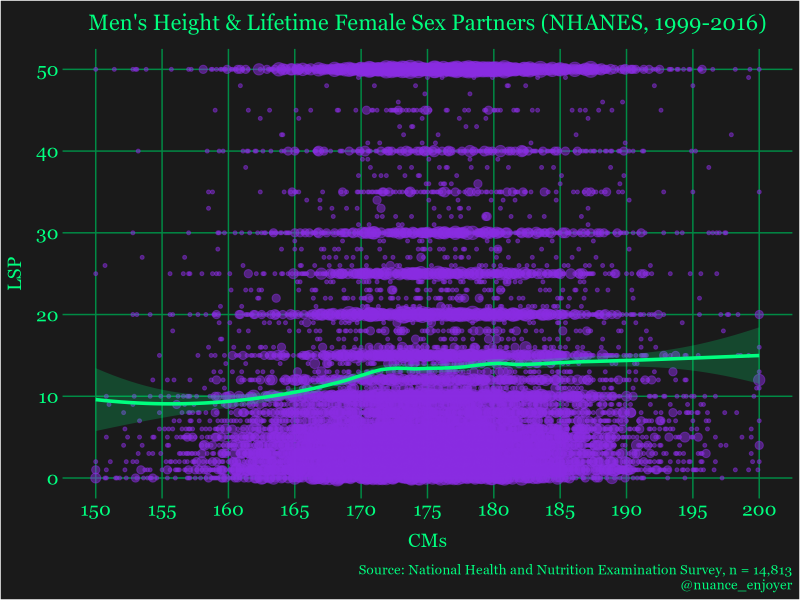
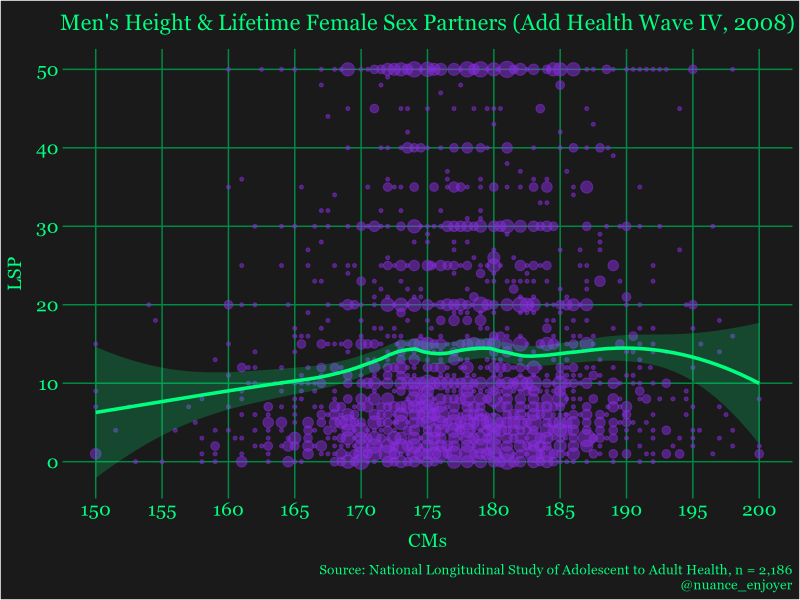
We see a quite similar patterns to the data in Frederick & Jenkins, 2015. While men below about 5’8 have noticeably (but not drastically) fewer partner counts on average, there’s not much happening past that point. The NHANES sex partner counts are higher on average likely due to a wider age range (The NSFG caps out at 45 until 2013-15 when it’s increased to 50). The NSFG also surveys adolescents, but I set the minimum age to 18. The Add Health likely has a higher mean due to the lower minimum age being higher, as subjects were 25-32 at the time.
“But Things Have Changed Bro!”
The most common critique will no doubt be that we need to look more specifically at young men in recent years to see the true extent of the effect, as they are the ones most affected by the ‘insane standards of modern women’, supposedly amplified by online dating, allowing them to filter out any men that don’t meet their unrealistic height standards, i.e. it’s now 6 feet+ or bust.
If we turn back to the NSFG and GSS datasets, we can see how the associations look in more recent years among young men heterosexual men, 18-24 for the NSFG but 18-30 for the GSS due to its limited sample size, even then the error margins are a lot wider. The sexual orientation variable isn’t available for the 2006-10 NSFG so I just left it out.
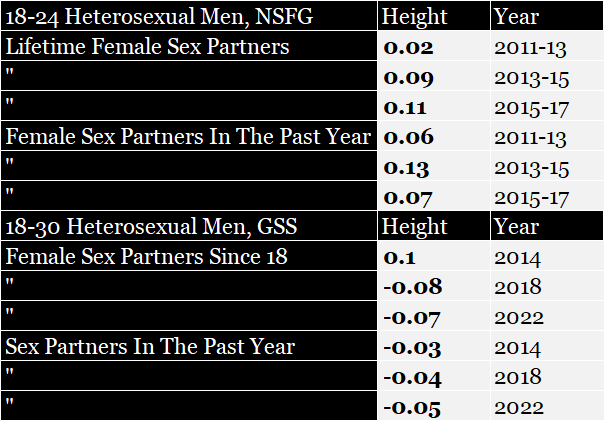
The correlations remain very weak and are all within each other’s error margins. There’s no indication here of height being under especially intense ‘selection’ among young men, or a strengthening of this association over the years.
This is what the GSS data from 2018-2022 looks like in a scatterplot:
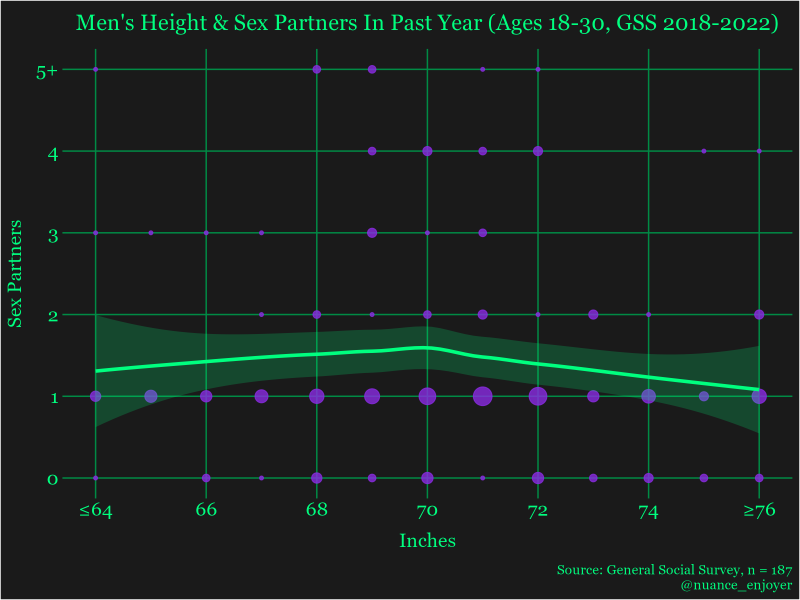
Considering the data we’ve seen, this slightly negative correlation is unlikely. However, the upper 95% CI for 2018 and 2022 together is .07. Therefore it’s also highly unlikely that there’s a strong positive correlation that we’re not seeing here.
Celibacy
Another question is, regardless of how much it correlates with total number of sex partners, what effect does it have on one’s likelihood of celibacy status? Could it be the case that while it doesn’t affect one’s overall ‘body count’ much, men who aren’t having or haven’t had sex at all are nonetheless significantly shorter?
In the NSFG dataset we find no significant differences in the mean heights of 18-24 men who did and didn’t have sex with a woman in the past year.
Two significant differences appeared for 25-30 men. Men who’d had sex in the past year were taller than their sexless counterparts in the 2006-10 and 2013-15 surveys, but both differences were less than an inch. This association also disappeared after aggregating the surveys.
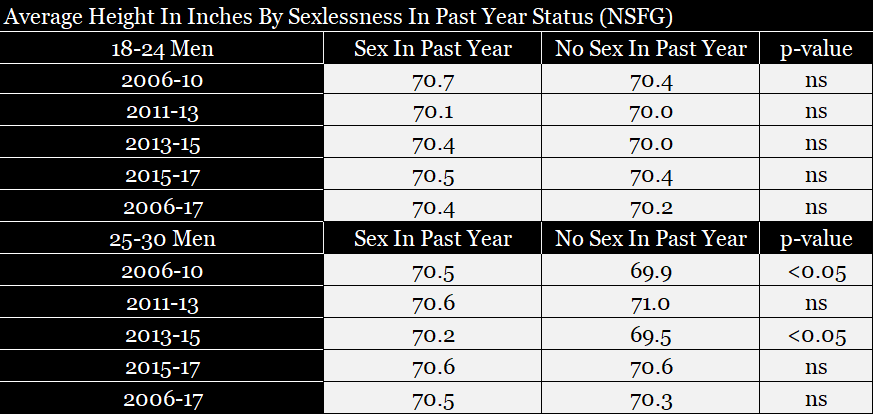
When it came to virginity, we do find a significant difference in the expected direction among 18-24 men in 2013-15 and overall. The overall gap was only .4 inches however, which would translate to a d value of .16, which is below Cohen’s recommended cutoff for a weak effect of .2.
For 25-30 men, the only difference was actually in the opposite direction, with virgins being taller on average in 2015-17. Let’s pour one out for our lanklet friends. The .4 inch overall gap with virgins being taller wasn’t significant however, as of course the 25-30 virgins had a significantly lower sample size.
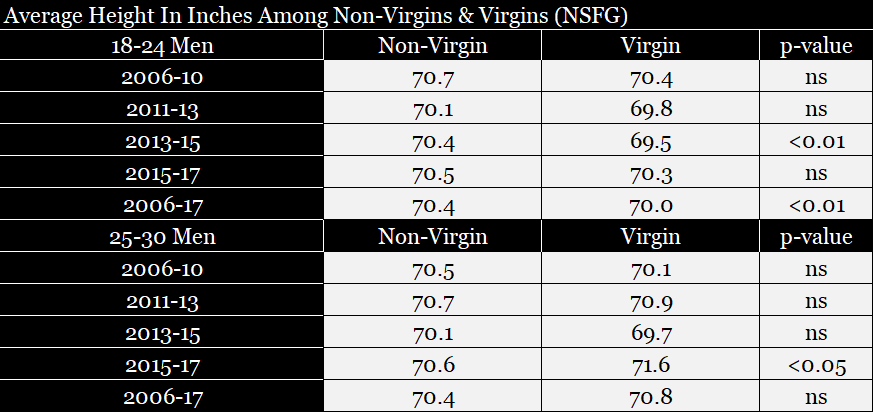
I also tried comparing men of varying height and age ranges, but you have to put in decent effort to tease out a significant difference.
So all in all we find a weak but significant effect of height upon virginity status among 18-24 men, but no effects when it came to 25-30 men.
One interpretation of these results is that while there might be a small effect of less short men losing their virginity earlier (as seen in Rhodes et al., though checking for it now I didn’t find this effect in the NSFG or Add Health datasets, if anything the effect was in the other direction, and controlling for race didn’t help, so I’m not confident about this, but nonetheless men who remain virgins past the normal age may still be slightly shorter), once we reach the mid to late 20s, there are very few men who remain virgins due to physical shortcomings, so to speak.
Again though, we’re talking a one centimetre difference at most. To put that into perspective, the difference between the average male height in the US (about 5’9) and 6’0 would be 7.5 centimetres.
Womanlets?
We saw in a couple of the studies that the correlation between height and sex partners for women was actually comparable to that of men. I whipped up a female version of the NSFG plot, showing a similar pattern:
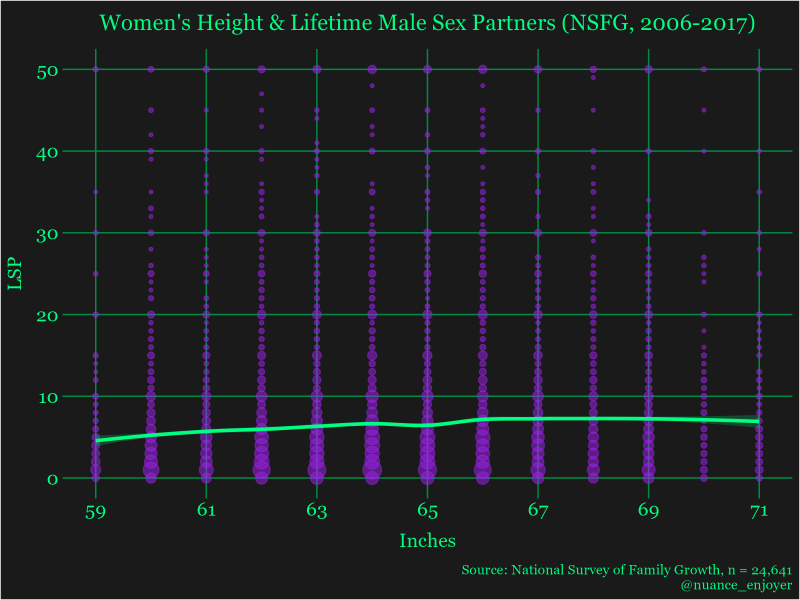
This association seems unusual considering shorter women presumably have a wider dating pool available to them due to their own preferences for dating men taller than themselves (and men’s of dating women shorter than them, even if typically less stringent a requirement).
It’s possible that taller (or at least non-short) women are more desirable as well. It’s true that models are taller than average, but I don’t know if it’s accurate to say that they perfectly represent men’s ideal woman. It could be because it helps them stand out on the runway for instance. The studies I’ve seen on height preferences don’t typically show taller women being more desired than shorter women.
It’s also not clear that being perceived as more desirable would lead women to accrue more sex partners. The weak association between physical attractiveness in men and their sexual experience is less consistent in women. It may even be the case that it’s reversed. For women, promiscuity isn’t bottlenecked by opposite-sex willingness in the same way. It is still possible though that they’d be more successful in finding romantic partners, at least ones that they found adequate, but if this doesn’t increase more facially attractive women’s sexual partner count then I don’t see why it would with women of a more desired height.
It could be the case that due to assortative mating for height, short women’s dating pool is more limited to shorter men, who even if above their own height they aren’t as interested in, leading to shorter people of both genders ending up with fewer sexual partners.
I’d suggest the possibility of taller women having higher libido, possibly due to higher testosterone, but again we’re dealing with an effect of shortness rather than tallness. If this were true we’d expect tall women to have more sex partners than average height women. I guess it’s possible that there’s a confluence of factors at play such as tall women indeed having a narrower pool of suitable partners but this effect being counteracted by taller women’s higher promiscuity. Since I don’t have much pertinent info to go off of and it’s not of obvious importance I’ll end the speculation here.
Conclusion
It looks like ‘chadliness’ doesn’t have much to do with sexual promiscuity after all, whether we’re talking about facial attractiveness or height. The vast majority of the variance in sex partners remains unexplained by either variable.
These results may even surprise some ‘normies’, as it’s not exactly an uncommon trope that tall men are pussy magnets. If they are, then they don’t seem to be too eager to capitalize on it, at least not in this way.
In reality, even assuming this gave you easy access to hookups left and right, it seems like the majority of ‘chads’ aren’t drawn to this lifestyle. Instead they tend to enter relationships and form pair bonds, like most people are hardwired to do. Additionally, when it comes to those who are short-term oriented, those who are less chad may be able achieve similar ends (in terms of partner count at least) by dropping their standards. It is also the case that non-physical traits like extraversion have a larger effect on sex partner count, so maybe it is the case that physical traits are not the most effective in achieving these ends either.
Of course it may have other effects, such as on ‘mate quality’ (maybe taller men have more attractive partners on average). Maybe their relationship satisfaction is higher (the Add Health dataset doesn’t seem to indicate this however). Maybe they have more reproductive success (most of the data I’ve came across doesn’t seem to indicate this either, will likely cover it in the future).
It’s not the case though that we found no effect of height whatsoever. I mean it’d be weird with how heavily it’s focused on if there weren’t. There is usually at least a small grain of truth to these things. We can safely rule out copes like the ‘6 foot rule’ however, and it seems to matter more in the sense that being short is something of a handicap rather than in the sense that being tall is a great advantage.
References
Rahman, Q., Korhonen, M., & Aslam, A. (2005). Sexually dimorphic 2D:4D ratio, height, weight, and their relation to number of sexual partners. Personality and Individual Differences, 39(1), 83–92. https://doi.org/10.1016/j.paid.2004.12.007
Rhodes, G., Simmons, L. W., & Peters, M. (2005). Attractiveness and sexual behavior: Does attractiveness enhance mating success? Evolution and Human Behavior, 26(2), 186–201. https://doi.org/10.1016/j.evolhumbehav.2004.08.014
Hill, A. K., Hunt, J., Welling, L. L. M., Cárdenas, R. A., Rotella, M. A., Wheatley, J. R., Dawood, K., Shriver, M. D., & Puts, D. A. (2013). Quantifying the strength and form of sexual selection on men’s traits. Evolution and Human Behavior, 34(5), 334–341. https://doi.org/10.1016/j.evolhumbehav.2013.05.004
Frederick, D. A., & Jenkins, B. N. (2015). Height and body mass on the mating market. Evolutionary Psychology, 13(3), 147470491560456. https://doi.org/10.1177/1474704915604563
Kordsmeyer, T. L., Hunt, J., Puts, D. A., Ostner, J., & Penke, L. (2018b). The relative importance of intra- and intersexual selection on human male sexually dimorphic traits. Evolution and Human Behavior, 39(4), 424–436. https://doi.org/10.1016/j.evolhumbehav.2018.03.008
Polo, P., Muñoz-Reyes, J. A., Pita, M., Shackelford, T. K., & Fink, B. (2019). Testosterone-dependent facial and body traits predict men’s sociosexual attitudes and behaviors. American journal of human biology : the official journal of the Human Biology Council, 31(3), e23235. https://doi.org/10.1002/ajhb.23235
von Borell, C. J., Kordsmeyer, T. L., Gerlach, T. M., & Penke, L. (2019). An integrative study of facultative personality calibration. Evolution and Human Behavior, 40(2), 235–248. https://doi.org/10.1016/j.evolhumbehav.2019.01.002
Seffrin, P., & Ingulli, P. (2021). Brains, brawn, and beauty: The complementary roles of intelligence and physical aggression in attracting sexual partners. Aggressive behavior, 47(1), 38–49. https://doi.org/10.1002/ab.21934

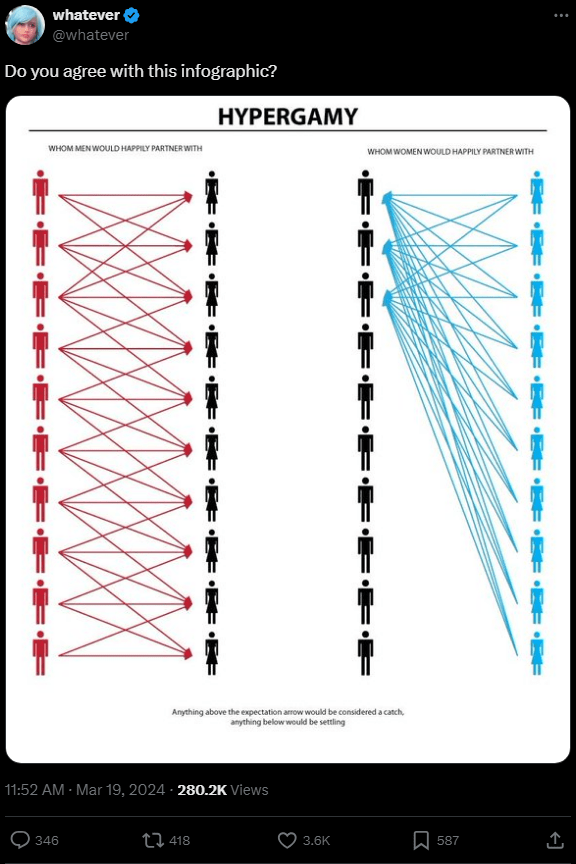
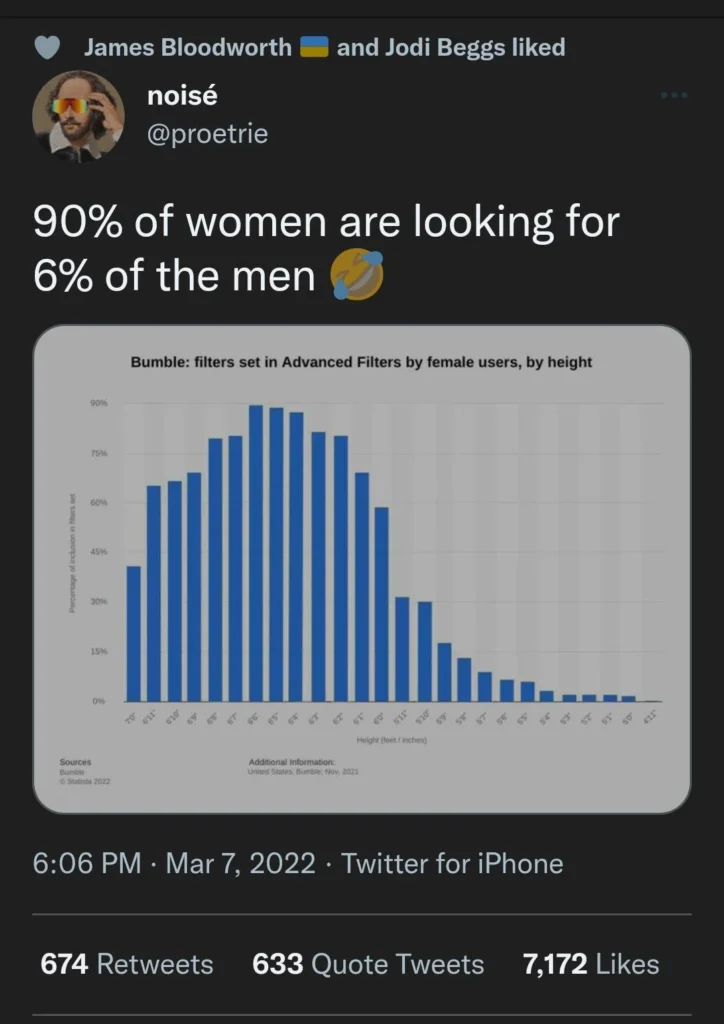
Sir,
Would it be possible for you to generate an article that specifically lists the qualities of fellows who do obtain coital gratification with regularity?
In other words, what gets a lad an adequate amount of poon.
I wonder how height influences long term mating. Because all researches above are talking about short term mating succession .
Точно стильные новости моды.
Абсолютно все новости мировых подуимов.
Модные дома, лейблы, гедонизм.
Лучшее место для трендовых хайпбистов.
https://rftimes.ru/news/2024-07-05-teplye-istorii-brend-herno
Модные заметки по подбору необычных видов на любой день.
Обзоры экспертов, события, все показы и шоу.
https://penposh.com/blogs/178061/%D0%A7%D1%82%D0%BE-%D1%82%D0%B0%D0%BA%D0%BE%D0%B5-%D0%B0%D0%B7%D0%B0%D1%80%D1%82%D0%BD%D1%8B%D0%B5-%D0%B8%D0%B3%D1%80%D1%8B